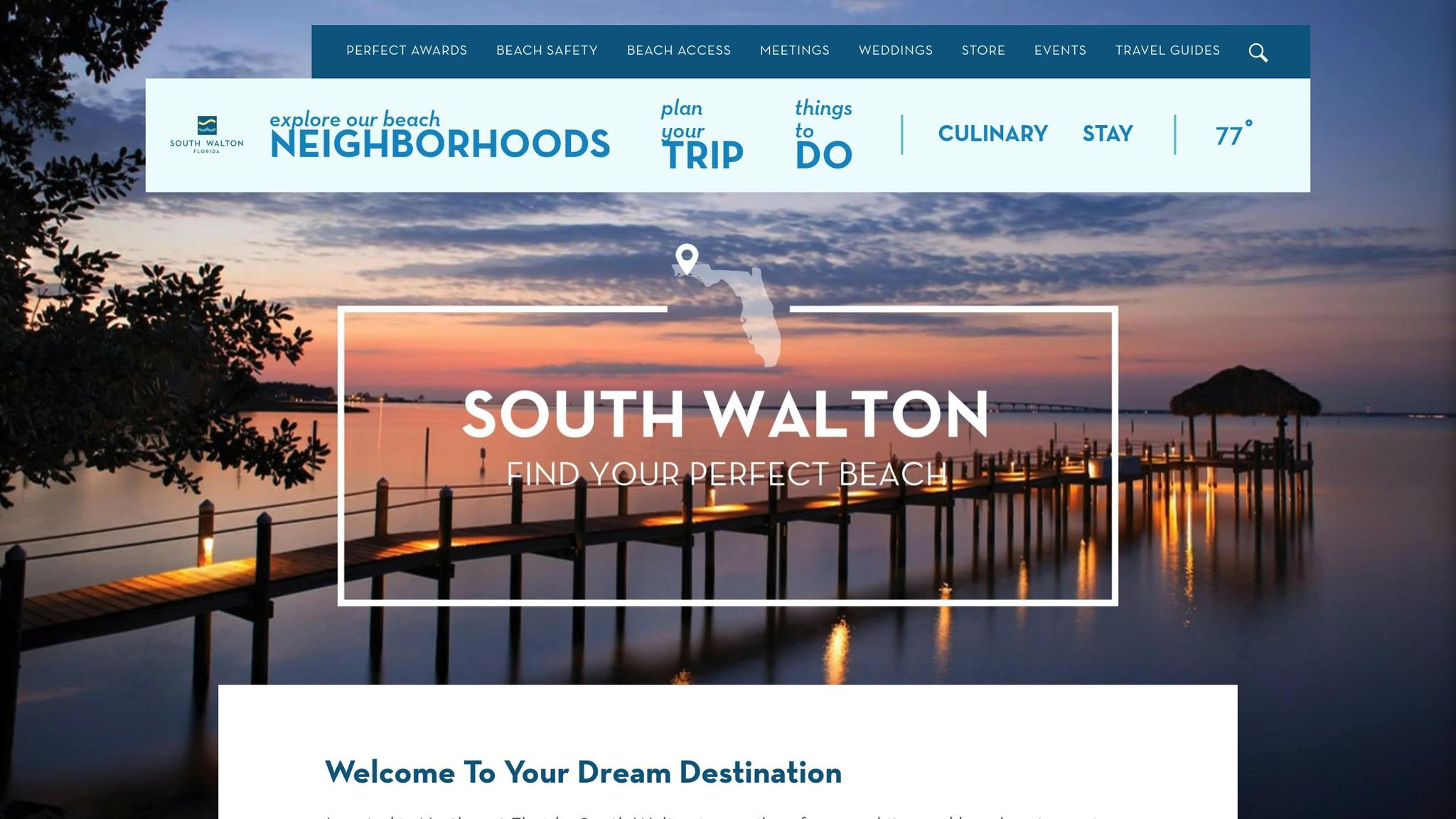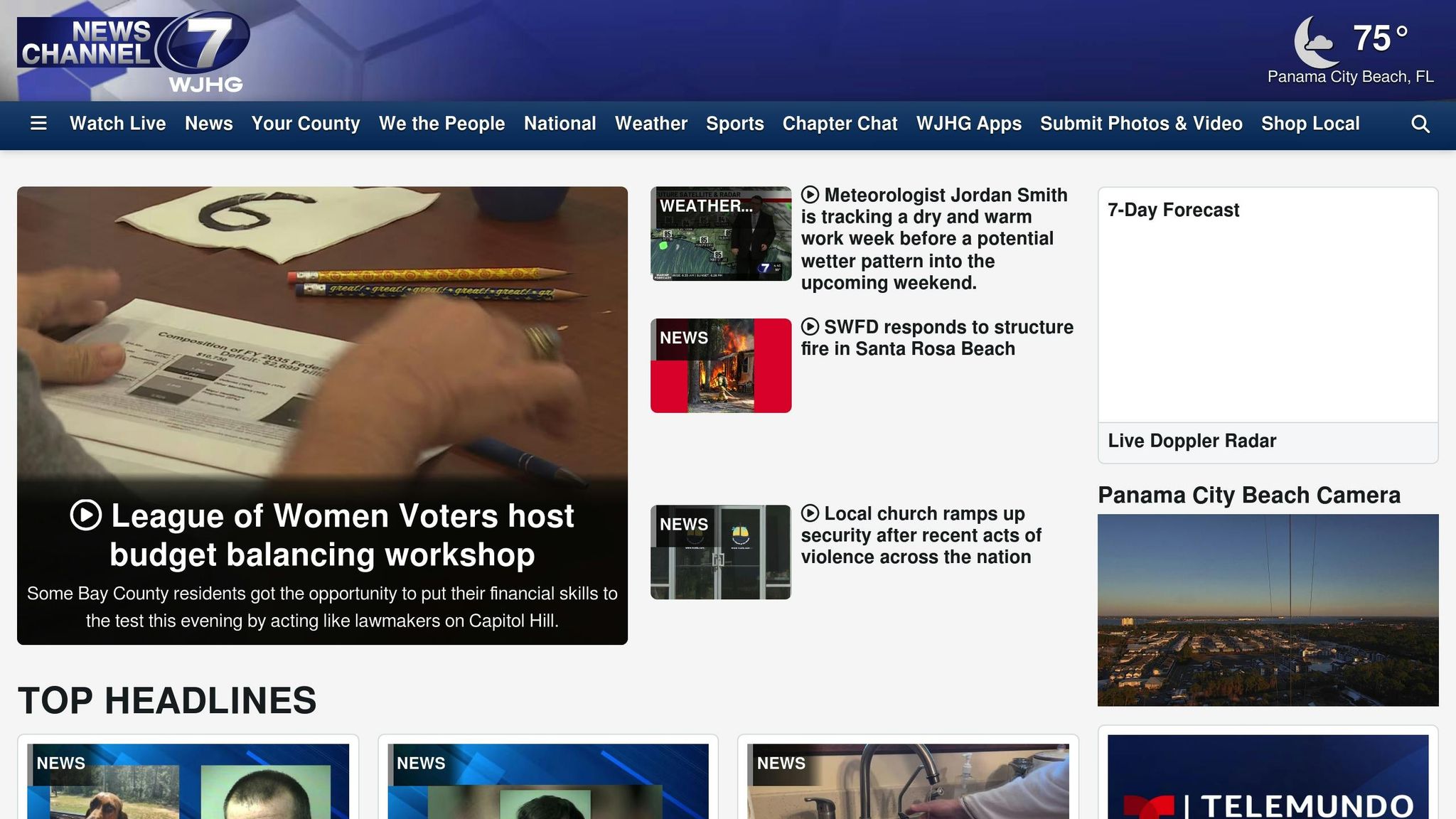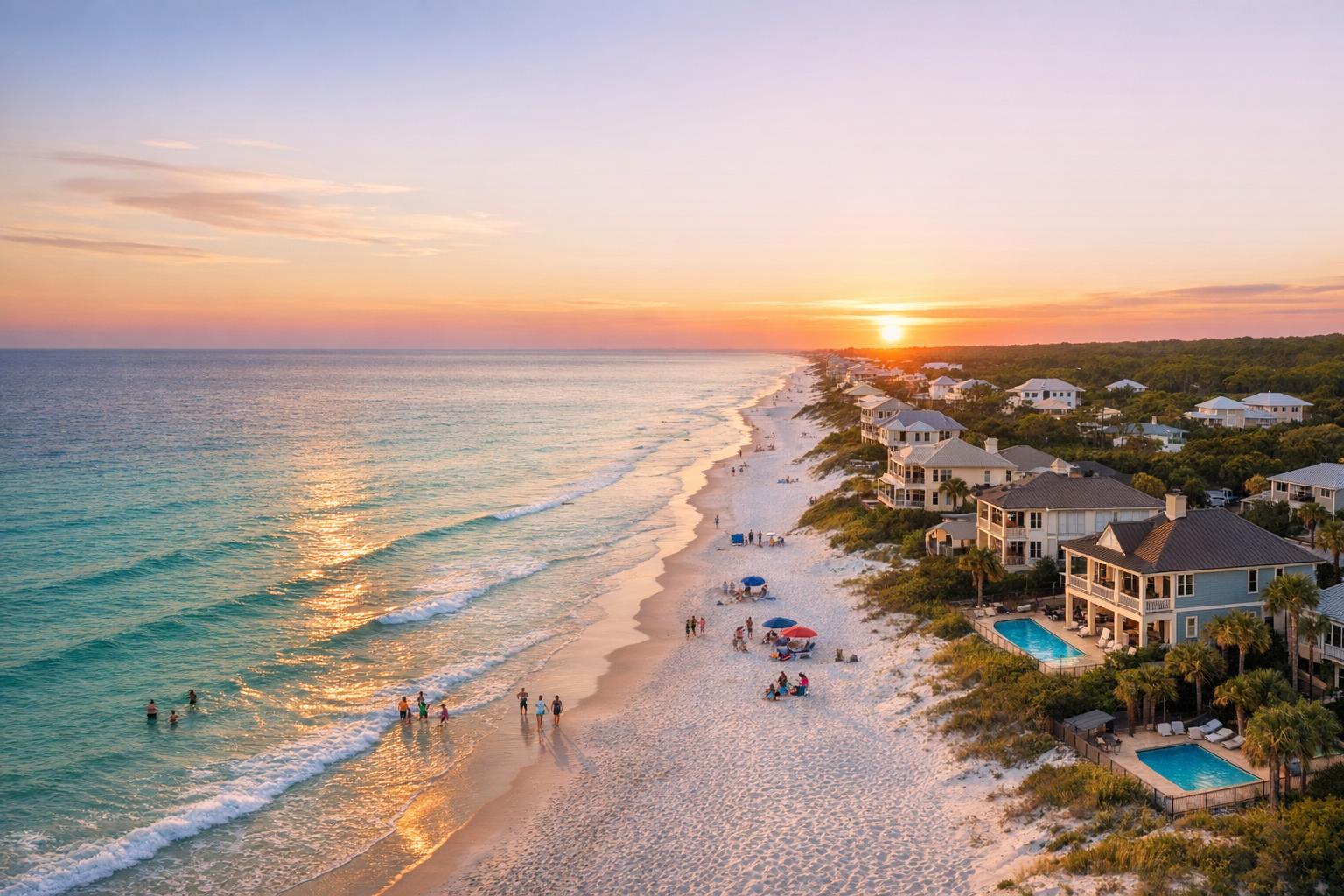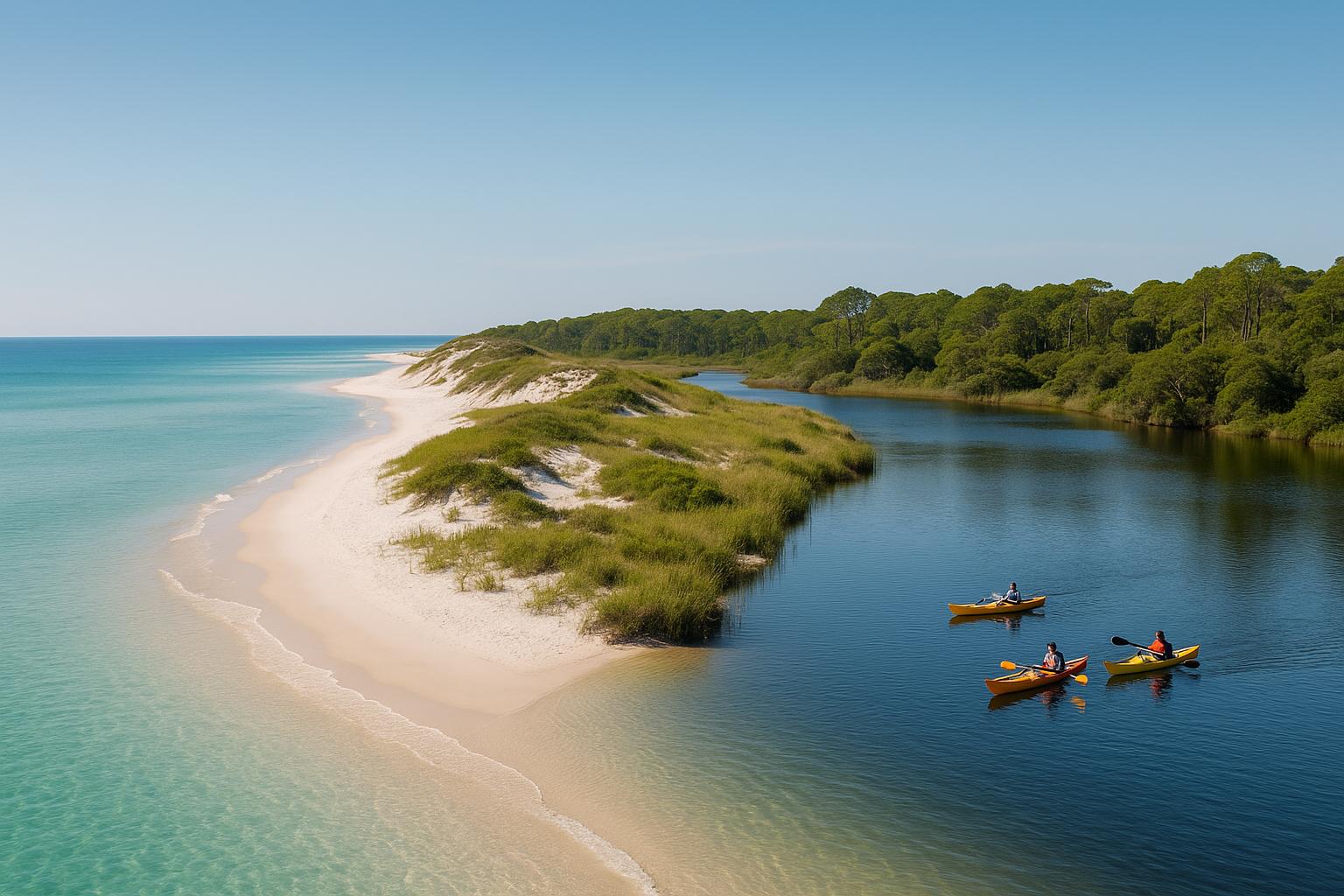South Walton faces a tough balancing act: protecting its stunning natural areas while accommodating growth in tourism and real estate. About 40% of its land is already conserved, including rare coastal dune lakes and state parks, but rapid development driven by tourism and rising property demand is reshaping the region. This has led to debates over land use, water resources, housing, and infrastructure.
Key points:
- Conservation efforts: Protect habitats, water quality, and natural landscapes through easements and land acquisition.
- Development drivers: Tourism and real estate boost jobs, tax revenue, and housing but strain resources and disrupt ecosystems.
- Challenges: Urban sprawl, water pollution, rising housing costs, and tension between property rights and environmental protection.
The future depends on balancing these priorities through zoning policies, public-private partnerships, and community engagement.
Land Conservation in South Walton

What Land Conservation Means in South Walton
In South Walton, efforts to protect its stunning coastal ecosystems hinge on thoughtful land management. One key approach is the use of conservation easements, where private landowners voluntarily agree to limit development on their property. This helps maintain habitats and preserve the area's natural beauty. Additionally, state-led land acquisitions play a crucial role in safeguarding fragile ecosystems, ensuring these spaces remain intact for future generations. Together, these strategies provide a foundation for focused conservation efforts throughout the region.
Major Conservation Projects
Local conservation projects aim to restore and protect South Walton’s coastal water bodies, beaches, and woodlands. By acquiring land and implementing conservation easements, these initiatives help reestablish native vegetation and minimize erosion in dune and beach areas. Beyond protecting the landscape, these efforts also strengthen the resilience of these ecosystems, setting the stage for long-term environmental health.
Why Conservation Matters
Preserving land in South Walton offers more than just aesthetic benefits - it’s vital for the region’s ecological and economic stability. Conservation efforts support a wide variety of species, enhance water quality, and provide natural defenses against storm surges and erosion. Additionally, they sustain eco-tourism, which is a key driver of the local economy, ensuring that both the environment and community thrive together.
Development Pressures in South Walton
What Drives Development
South Walton's rapid growth is fueled by two key forces: tourism and a booming real estate market. Tourism serves as the backbone of Walton County's economy, creating a ripple effect across hospitality and related industries. Visitors bring in significant revenue through direct spending, which not only boosts local businesses but also contributes to tax revenues that benefit households and fund public services.
Meanwhile, the real estate market is thriving, with property values skyrocketing and buyers fiercely competing for limited options, especially along the sought-after 30A corridor. This demand isn't just limited to primary residences - investment properties, particularly for short-term rentals, play a major role in the area's economic landscape. The combination of high demand and limited land availability continues to push development forward, often clashing with conservation efforts and creating a delicate balancing act for the region.
Economic and Social Benefits of Development
The economic advantages of South Walton's development are undeniable. Construction projects bring jobs to the area, offering opportunities for workers across various roles like builders, designers, and project managers. Beyond the construction phase, development supports long-term employment in sectors such as hospitality, retail, and property management.
Short-term rentals also play a key role in strengthening the local economy. They generate property income for owners while driving demand for services like cleaning, maintenance, and tourism-related activities. Together, these factors illustrate how ongoing development is shaping South Walton's economic landscape.
WJHG FLASHBACK: 30A in South Walton County Before Development in 1987

Challenges and Debates
South Walton's efforts to balance conservation with development often lead to conflicts, particularly when it comes to preserving the area's natural beauty while addressing the needs of a growing population. These challenges touch on complex issues like property rights, environmental preservation, and economic pressures.
Land Use and Natural Resource Issues
Urban sprawl is a growing concern as rural landscapes give way to subdivisions and commercial developments. This not only fragments wildlife habitats but also threatens ecosystems like the rare coastal dune lakes, which are among the area's most distinctive features.
Water resources are also under strain. As the population grows, the demand for water increases, putting pressure on aquifers and stormwater systems. Urban development exacerbates the problem by accelerating runoff, which carries pollutants into fragile coastal waters.
The decline of agricultural and forestry lands further complicates the picture. Family farms and timber operations, many of which have been around for generations, are increasingly surrounded by development. Rising property values make it financially challenging for landowners to maintain these traditional uses, even when they wish to preserve their rural way of life.
Property rights disputes often arise when developers and conservationists push for new restrictions. These disputes can lead to lengthy legal battles, delaying both conservation efforts and development projects.
Beyond these environmental and land use challenges, policy disagreements add another layer of complexity to South Walton's growth management.
Local Debates and Policy Disagreements
Coastal Dune Lake protections are a frequent source of tension. These globally rare ecosystems, found in places like Western Lake and Grayton Beach State Park, are highly sensitive to nearby development. Proposals for construction near these lakes often pit environmental groups and concerned residents against property owners and business interests, with disagreements over buffer zones and development standards.
Density proposals also ignite debates. Some argue that increasing housing density could reduce the pressure to develop more land, but others worry it would strain infrastructure and alter the area's small-town atmosphere.
Short-term rental regulations are another contentious issue. While these rentals contribute to the local economy, they can disrupt neighborhood dynamics and lead to overuse of natural areas. Residents often cite increased traffic, noise, and wear on beaches and parks as major concerns.
Infrastructure funding discussions highlight the delicate balance between growth and conservation. While new developments generate tax revenue that could support conservation efforts, they also create demands for roads, utilities, and other services that may encroach on natural areas. Local officials must navigate these competing priorities while managing taxpayer expectations.
The affordable housing crisis adds yet another layer of difficulty. Soaring property values make it nearly impossible for essential workers - like teachers, firefighters, and service industry employees - to find housing they can afford. This forces tough decisions between preserving open spaces and creating workforce housing that supports the local economy.
These ongoing debates underscore the challenge of finding harmony between growth and the preservation of South Walton's unique character and environment.
sbb-itb-d06eda6
Side-by-Side Comparison: Conservation vs. Development
Balancing conservation and development in South Walton is a delicate act, with each approach offering distinct advantages and challenges that shape the area's future.
Conservation efforts focus on safeguarding South Walton's natural beauty and ecosystems, but they can also limit economic opportunities and impose restrictions on property owners. On the other hand, development promotes economic growth and provides much-needed housing, though it often comes at the expense of the region's unique environmental features.
This tension becomes particularly clear when considering long-term sustainability. Conservation helps protect South Walton's coastal dune lakes and pristine beaches, ensuring these vital ecosystems remain intact. However, without sufficient development, local workers often face unaffordable housing options, forcing them to commute from more affordable areas.
Here’s a closer look at the trade-offs:
Comparison Table
| Environmental Benefits | Conservation Challenges | Economic Benefits | Development Challenges |
|---|---|---|---|
| Protects coastal dune lakes and native ecosystems | Limits land availability for housing and commercial projects | Creates jobs in construction, retail, and hospitality | Fragments wildlife habitats and threatens sensitive ecosystems |
| Maintains water quality in aquifers and coastal waters | Restricts property owners' ability to develop their land | Generates tax revenue for infrastructure and public services | Increases stormwater runoff and coastal water pollution |
| Preserves scenic beauty that attracts tourism | Reduces immediate economic opportunities for landowners | Provides workforce housing and essential services | Contributes to urban sprawl and loss of rural character |
| Supports outdoor recreation and sustainable fishing | Requires ongoing funding and management | Improves infrastructure like roads, utilities, and schools | Strains water resources and waste management systems |
| Maintains property values through environmental quality | May conflict with emergency services and accessibility needs | Attracts businesses and diversifies the economy | Risks pricing out long-term residents and essential workers |
| Protects agricultural and forestry heritage | – | Enhances transportation and connectivity | Increases traffic congestion and residential noise levels |
Neither conservation nor development alone can address all of South Walton's needs. A balanced approach - integrating targeted conservation with thoughtful development - offers the best path forward. For instance, concentrating development in already altered areas while protecting ecologically sensitive regions can help. Similarly, creating mixed-use communities can reduce sprawl while preserving open spaces.
Achieving harmony between environmental preservation and economic growth requires innovative planning, active community involvement, and policies that prioritize both conservation and development goals.
Results and Future Directions
The ongoing push and pull between conservation and development in South Walton has led to both achievements and persistent challenges.
Conservation Wins and Challenges
Efforts to preserve South Walton's fragile ecosystems have seen notable successes. State parks and conservation easements have safeguarded thousands of acres, including coastal dune lakes and longleaf pine forests. These protected areas now serve as essential wildlife corridors, offering a refuge for native species.
But conservation faces hurdles. The relentless pace of development has outstripped the ability to preserve key land parcels. Skyrocketing property values make it harder for conservation groups to acquire critical areas, especially near the coast. Some landowners, once supportive of preservation, have shifted their stance due to rising property taxes and lucrative offers from developers.
Development Gains and Side Effects
Development has undeniably brought economic benefits. Job creation has surged, and increased tax revenues have funded essential public services. Some master-planned communities have embraced green building practices, setting aside significant portions of land as open space.
However, rapid growth has come with its share of problems. Infrastructure struggles to keep up, and traffic congestion during peak tourist seasons now spills into other parts of the year. Housing costs have soared, forcing many workers to live in neighboring counties and commute. Historic neighborhoods have also changed, with modest older homes giving way to sprawling vacation properties. These shifts have sparked creative policy experiments to address the ripple effects.
New Policy Directions
Local governments are testing innovative zoning strategies to strike a balance between development and conservation. For instance, transfer of development rights programs let landowners in sensitive areas sell their development potential to buyers in less vulnerable locations.
Public-private partnerships are also gaining traction. Some developers are voluntarily exceeding environmental standards in exchange for faster permitting. Conservation groups are collaborating more closely with the real estate sector to find solutions that benefit both sides. These efforts are bolstered by growing public engagement, which has brought fresh ideas to the table.
Community Involvement and Future Planning
Public participation in land use decisions has grown significantly over the past decade. Town hall meetings now attract hundreds of residents, while online forums on development issues see active discussions from both long-time locals and newer arrivals. This increased engagement has led to more nuanced conversations that go beyond simple "pro-development" or "pro-conservation" debates.
Looking ahead, South Walton faces mounting pressures. Population growth is expected to continue, and climate change poses new threats, including rising sea levels and stronger storms. Planners are beginning to consider long-term scenarios that previous generations didn't need to address.
Interestingly, younger residents seem to lean toward sustainable development models that integrate economic progress with environmental care.
The Road Ahead
South Walton's journey highlights that neither full-scale conservation nor unchecked development can solve the challenges of a rapidly growing coastal community. The best outcomes have come from collaboration - when conservationists, developers, officials, and residents join forces to create solutions that respect both economic needs and environmental boundaries.
The decisions made in the next five to ten years will define South Walton's future. Achieving a balance will require continued public involvement, creative policy-making, and a shared commitment to finding middle ground rather than treating conservation and development as opposing forces. The path forward lies in working together to shape a community that values both its natural heritage and its economic vitality.
Conclusion
South Walton’s ongoing debate over conservation and development reflects a familiar struggle for many U.S. coastal communities. At its core, the challenge lies in finding a way to protect the area’s natural beauty while also creating opportunities for economic growth. Leaning too heavily on conservation could stifle progress, but unchecked development threatens to harm delicate ecosystems.
Some promising approaches are already in play. For instance, transfer of development rights programs offer a way for landowners to earn financial benefits while steering growth away from environmentally sensitive areas. Public-private partnerships are also stepping up, working to achieve high environmental standards while contributing to jobs and tax revenue. On top of that, greater community involvement has brought more voices to the table, enriching land use planning with a wider range of local perspectives.
Looking ahead, South Walton faces some tough tests. Climate change, rising sea levels, and population growth will all challenge the area’s ability to maintain a sustainable balance. The key to tackling these issues will be collaboration - bringing together conservationists, developers, local leaders, and residents to find solutions that work for everyone.
For those exploring South Walton through sowal.co, this balance explains why some areas remain untouched while others are developed. It’s a reminder of the importance of working together to protect the region’s natural treasures while supporting thoughtful growth. Success will depend on everyone’s commitment to preserving the area’s heritage while embracing opportunities for the future.
FAQs
What steps can South Walton take to grow its economy while protecting its natural environment?
South Walton has the potential to find harmony between growing its economy and protecting its natural surroundings by embracing development approaches that prioritize long-term health and balance. This means putting in place land use rules designed to ensure resilience over time, promoting tourism that respects the environment, and supporting businesses that adopt eco-conscious practices.
With almost 40% of the area already designated as protected land, preserving these spaces is critical to maintaining the unique charm and allure of the region. By adopting thoughtful growth strategies, South Walton can pave the way for economic progress while ensuring its ecosystems remain intact for generations to come.
How do urban sprawl and rising housing costs affect South Walton’s communities and environment?
Urban sprawl in South Walton poses serious risks to local ecosystems. It leads to habitat loss, a decline in biodiversity, and land degradation. These changes not only harm the environment but also jeopardize the natural landscapes that make the area so appealing to both residents and visitors.
On top of that, increased development drives up housing costs, creating economic pressures for long-time residents. Higher living expenses can force some people out, changing the community's character and deepening socio-economic divides. The rapid pace of growth also puts a strain on infrastructure and public services, which can negatively affect the overall quality of life for those who call South Walton home.
What are conservation easements, and how do they help protect South Walton’s unique coastal ecosystems?
Conservation easements are binding legal agreements designed to restrict land use in order to protect its natural features, wildlife habitats, and overall environmental importance. These agreements are usually formed between landowners and either conservation groups or government bodies, ensuring the land stays untouched and preserved for generations to come.
In South Walton, these easements are especially crucial for shielding delicate coastal ecosystems. By keeping open spaces intact and protecting habitats, they help sustain the region’s biodiversity, curb overdevelopment, and uphold the natural systems that benefit both the environment and the people who live there.



